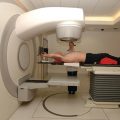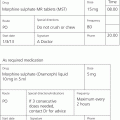Chapter 2 Daniel L.Y. Lee St James’ Institute of Oncology, UK Symptoms can range in severity and are most commonly divided into two groups: Specific treatment will depend on the severity of the reaction and the drug which is being infused. Each department should have guidance on the local protocol, but general guidance is given below. After the acute episode has abated further treatment with the offending drug may be considered. This is dependent on the grade of the reaction and the ‘value’ of pursuing further treatment with the same drug, or the benefits of any possible alternatives. There may be the possibility of increasing premedication regimens for the reaction or reducing the infusion rate. All such decisions should be undertaken by a senior member of the treating team. Refer to local guidelines regarding drug re-challenges and for desensitisation protocols. Bleeding can occur in up to 10% of patients with advanced cancer. This may increase to up to 30% in those with a haematological malignancy. There are multiple causes for bleeding in cancer patients: Concurrent infection can raise the risk of bleeding due to inflammation. Antibiotic treatment may lower the risk. The presentation can vary markedly: Appropriate management will depend on assessing: Identify the site of bleeding from history and examination. Note: a minor bleed may herald further more severe bleeding. Patients receiving adjuvant or curative treatment should be treated as per any other patient, with prompt assessment and intervention as needed. Major catastrophic haemorrhage is rare in cancer patients, but should be assessed in an acute environment and with the use of appropriate local protocols. Most emergency departments will have a specific catastrophic haemorrhage algorithm. Blood tests and IV access should be sought early and IV fluids administered as appropriate. IV fluids may further dilute the blood, so consider the use of blood products (see section on systemic interventions). Particular consideration should be given to the patients’ prior treatment and the bleeding risk associated with this, for example after surgery. There are situations where patients at the end of life may have an unexpected or predicted catastrophic bleeding event. These should be managed with a very different approach, as detailed in the next section. Interventional radiology: Transcutaneous arterial embolisation with beads/particles, glue or coils: Vitamin K: Associated with malignancy, sepsis and trauma. There is increased thrombin formation (with associated decreased fibrinogen, PT and APTT) and increased fibrinolysis (with associated increased d-dimer). There is an associated poor prognosis. The basis of treatment is: Advanced planning is crucial in palliation of expected catastrophic bleed. Patients undergoing palliation should have their chances of an acute catastrophic bleed identified early. An early, sensitive discussion with the family and patient about their wishes is paramount and can provide forewarning and reassurance. ‘Do not attempt resuscitation’ orders should be discussed and completed prior to any event. Patients who are particularly at risk are those with: The central focus of intervention is: Chapter 3, sections on anaemia, thrombocytopenia Table 2.1 CTCAE (V4.03) grading of tracheal obstruction. From the website of the National Cancer Institute (http://www.cancer.gov). Table 2.2 CTCAE (V4.03) grading of stridor. From the website of the National Cancer Institute (http://www.cancer.gov). CAO can be the result of malignant or non-malignant causes. Malignancy is the most common pathology, and the most common malignant pathology leading to CAO is lung cancer. Lung cancer can obstruct the airway intraluminally or through extraluminal compression. Malignant causes include: Non-malignant processes include: Symptoms are dependent upon the degree of airway stenosis. In some cases, symptoms can develop rapidly and become life threatening. Symptoms include: There are multiple interventional procedures now available in the management of CAO. The optimum choice is dependent upon a number of patient factors (such as performance status and wishes), cancer and prognostic factors and local availability. Optimum intervention selection should involve an MDT, if time allows. Stent related issues include: mucostasis, stent migration, colonisation with bacteria or fungi and possible subsequent pneumonia/lung abscesses. Re-stenosis due to tumour overgrowth or excessive granulation tissue formation may be overcome with a further stent, cryotherapy or argon plasma coagulation (APC). Extravasation is the leakage of a pharmacological or biological agent from the infusion site into the surrounding tissue. The grading of extravasation is shown in Table 2.3. Table 2.3 CTCAE (V4.03) grading of extravasation. From the website of the National Cancer Institute (http://www.cancer.gov). The incidence of extravasation is unclear and there is variability in the guidelines of its management. Chemotherapeutic agents can be classified into categories based on their potential to cause damage and this is central to the management of extravasation. These categories are: However, these categories are not absolute and may depend on the volume of drug extravasated and the concentration of the infusion (e.g. a classically irritant drug can cause a vesicant reaction). Chemotherapeutic agents and their extravasation potential are listed in Table 2.4. Table 2.4 Chemotherapeutic categories Adapted from Perez Fidalgo JA et al. Ann Oncol 2012; 23:vii167–73. Reproduced with permission of Oxford University Press. 1 Bendamustine is classified as a vesicant but reports have since described soft tissue damage on extravasation. 2 May have vesicant or irritant properties, dependent upon the volume of the drug extravasated. Greater volume or concentration of the drug is associated with higher vesicant potential. 3 May have irritant properties, dependent upon the volume of the drug extravasated. Early signs that a drug may be extravasating include: Table 2.5 Chemotherapeutic agents that may cause a local reaction.
Oncological emergencies
Anaphylaxis and hypersensitivity reactions
Definition
Causes
Symptoms and signs
Management
Localised hypersensitivity reaction
Anaphylaxis
Observation and biphasic reactions
Ongoing management and retreatment
References
Bleeding
Overview
Clinical presentation
Clinical assessment
Management
General measures
Local interventions
Systemic interventions
Disseminated intravascular coagulopathy (DIC)
End of life considerations/catastrophic bleed
Other relevant sections of this book
References
Central airway obstruction and stridor
Definition
Grade
Criteria
1
Partial symptomatic obstruction on examination (e.g. visual, radiologic or endoscopic).
2
Symptomatic (e.g. noisy airway breathing), no respiratory distress, medical intervention indicated (e.g. steroids), limiting ADL.
3
Stridor, radiologic or endoscopic intervention indicated (e.g. stent, laser); limiting self-care ADL.
4
Life-threatening airway compromise; urgent intervention indicated (e.g. tracheotomy or intubation).
5
Death.
Grade
Criteria
1
—
2
—
3
Respiratory distress limiting self-care ADL; medical intervention indicated.
4
Life-threatening airway compromise; urgent intervention indicated (e.g. tracheotomy or intubation).
5
Death.
Causes
Symptoms
Investigation
Management
General management
Specific anti-cancer treatments
Endoscopic procedures
References
Extravasation
Definition
Grade
Criteria
1
—
2
Erythema with associated symptoms (e.g. oedema, pain, induration, phlebitis).
3
Ulceration or necrosis; severe tissue damage; operative intervention indicated.
4
Life-threatening consequences; urgent intervention indicated.
5
Death.
DNA-binding Vesicants
Non-DNA-binding Vesicants
Irritants
Non-Vesicants
Alkylating Agents
Vinca Alkaloids
Alkylating Agents
Asparaginase
Mecholretamine
Vinblastine
Ifosfamide
Bleomycin3
Bendamustine1
Vincristine
Streptozocin
Bortezomib
Carmustine2
Vindesine
Dacarbazine2
Cladiribine
Vinorelbine
Melphalan
Cytarabine
Anthracyclines
Cyclophosphamide
Doxorubicin
Taxanes
Anthracyclines (other)
Fludarabine
Daunorubicin
Docetaxel (rare)
Liposomal doxorubicin
Gemcitabine
Epirubicin
Paclitaxel (rare)
Liposomal daunorubicin
Interferons
Idarubicin
Mitoxantrone
Interleukin-2
Others
Methotrexate
Others (Antibiotics)
Trabectedin
Topoisomerase II inhibitors
Monoclonal antibodies
Amsacrine
Etoposide
Pemetrexed
Dactinomycin
Teniposide
Raltitrexed
Mitomycin C
Temsirolimus
Mitoxantrone2
Antimetabolites
Thiothepa3
5-FU
Platinum Salts
Carboplatin
Cisplatin2
Oxaliplatin2
Topoisomerase I inhibitors
Irinotecan
Topotecan
Others
Ixabepilone
Arsenic trioxide
Melphalan
Trastuzumab
Risk factors and prevention of extravasation
Diagnosis
Differential diagnoses
Local skin reactions
Chemical phlebitis
Aspariginase
Amsacrin
Cisplatin
Carmustine
Daunorubicin
Dacarbazine
Epirubicin
Epirubicin
Fludarabine
5-FU (as continual infusion in combination with cisplatin)
Mechlorethamine
Gemcitabine
Melphalan
Mechlorethamine
Vinorelbine
Management
Stay updated, free articles. Join our Telegram channel

Full access? Get Clinical Tree





